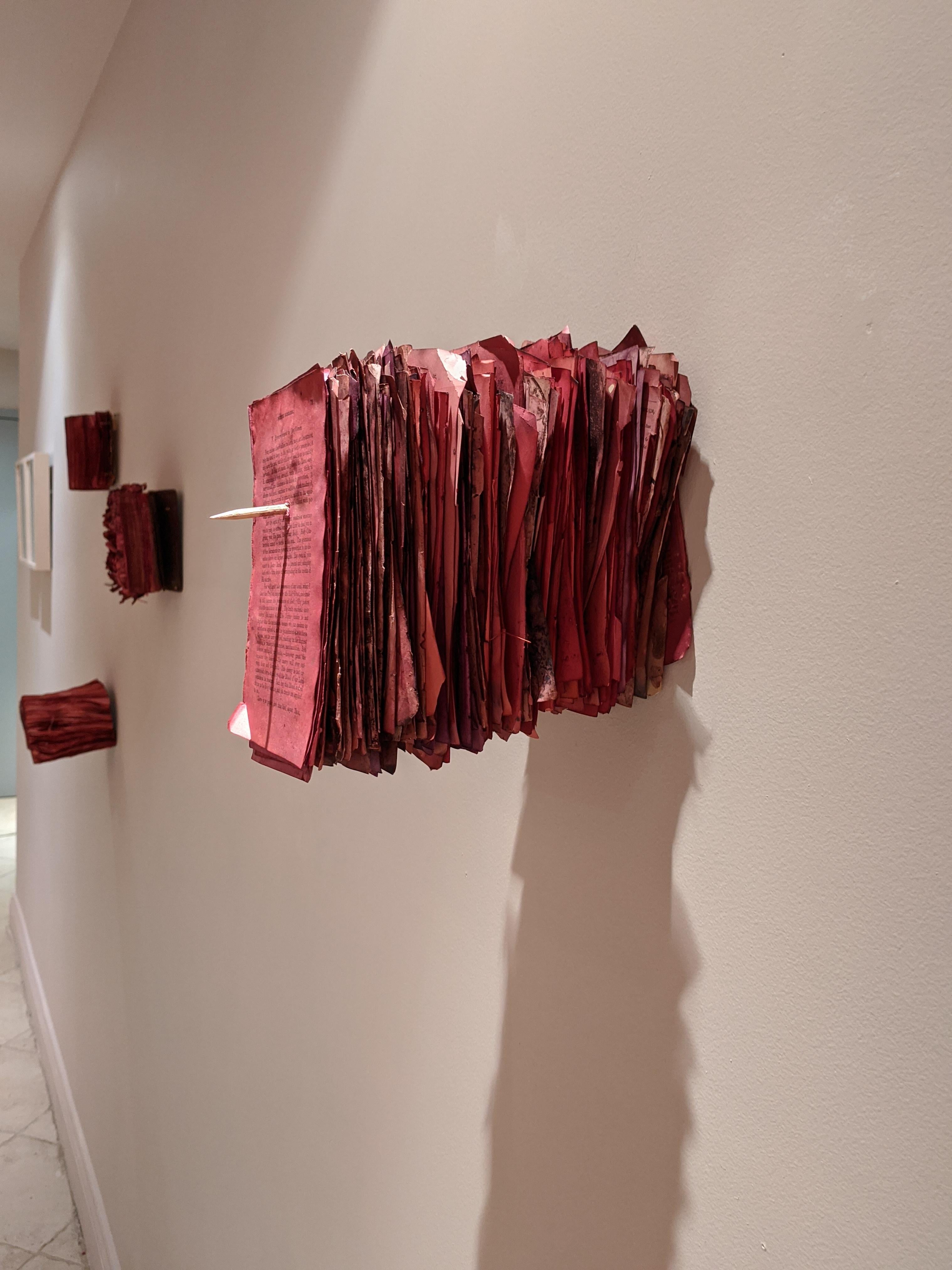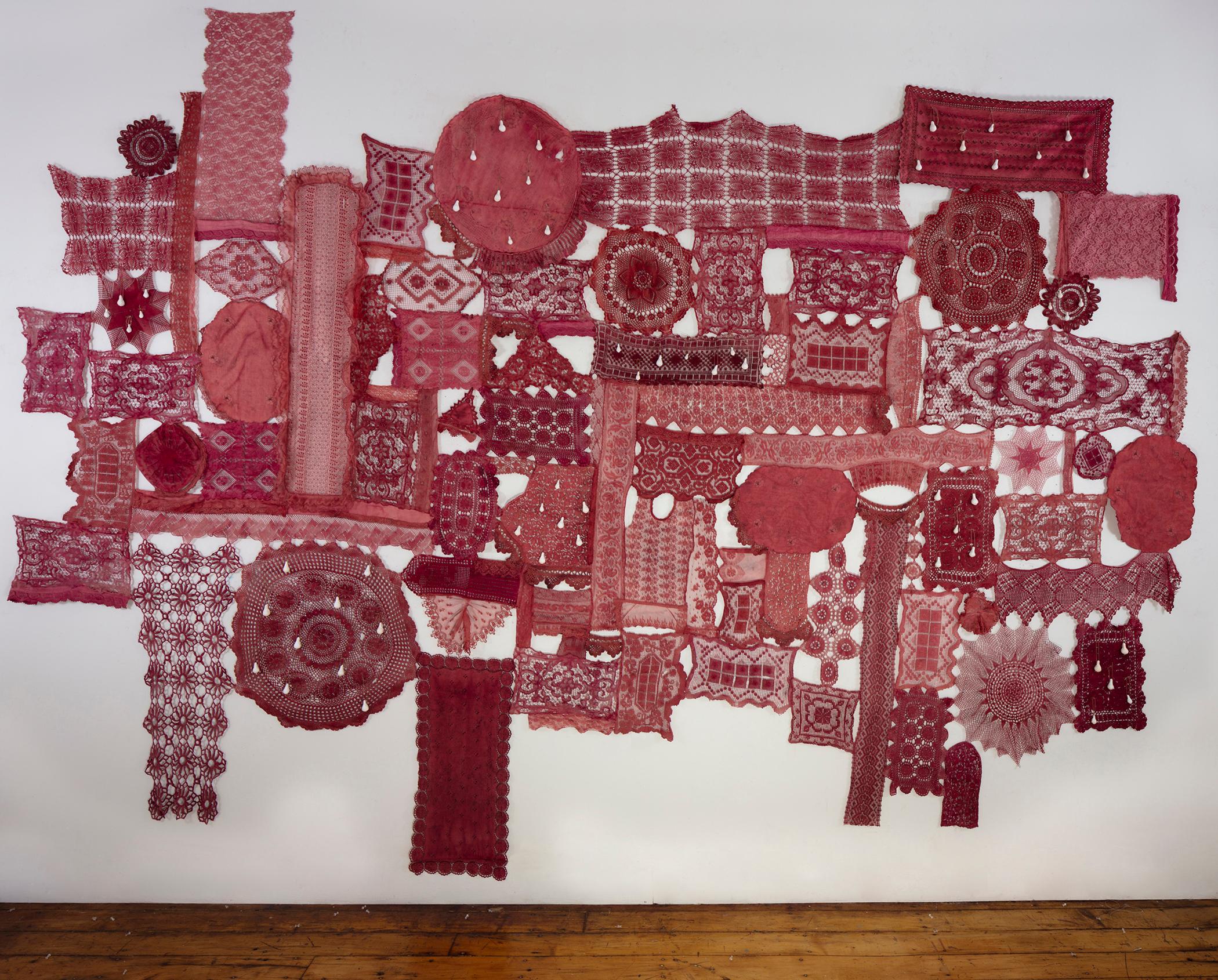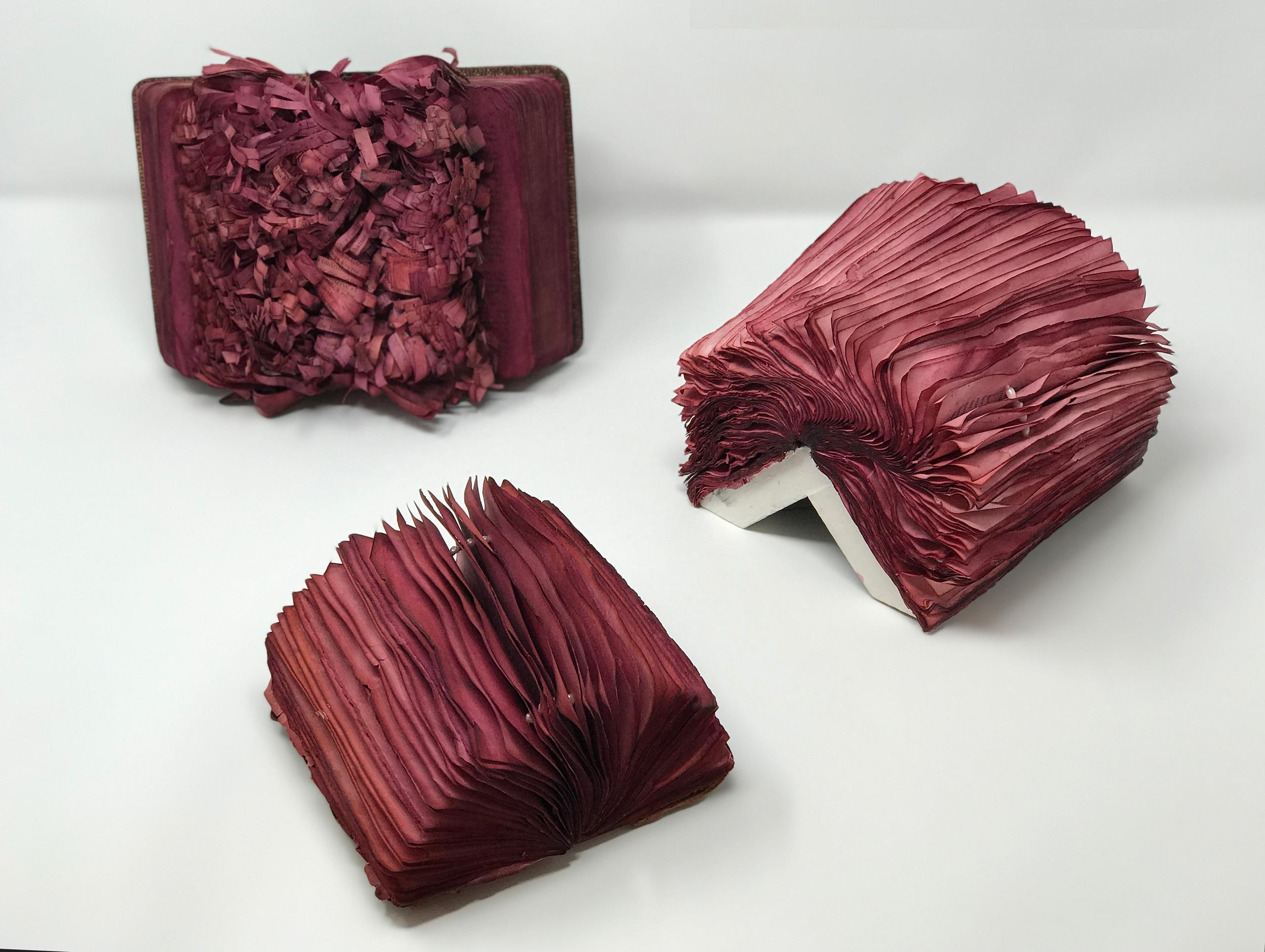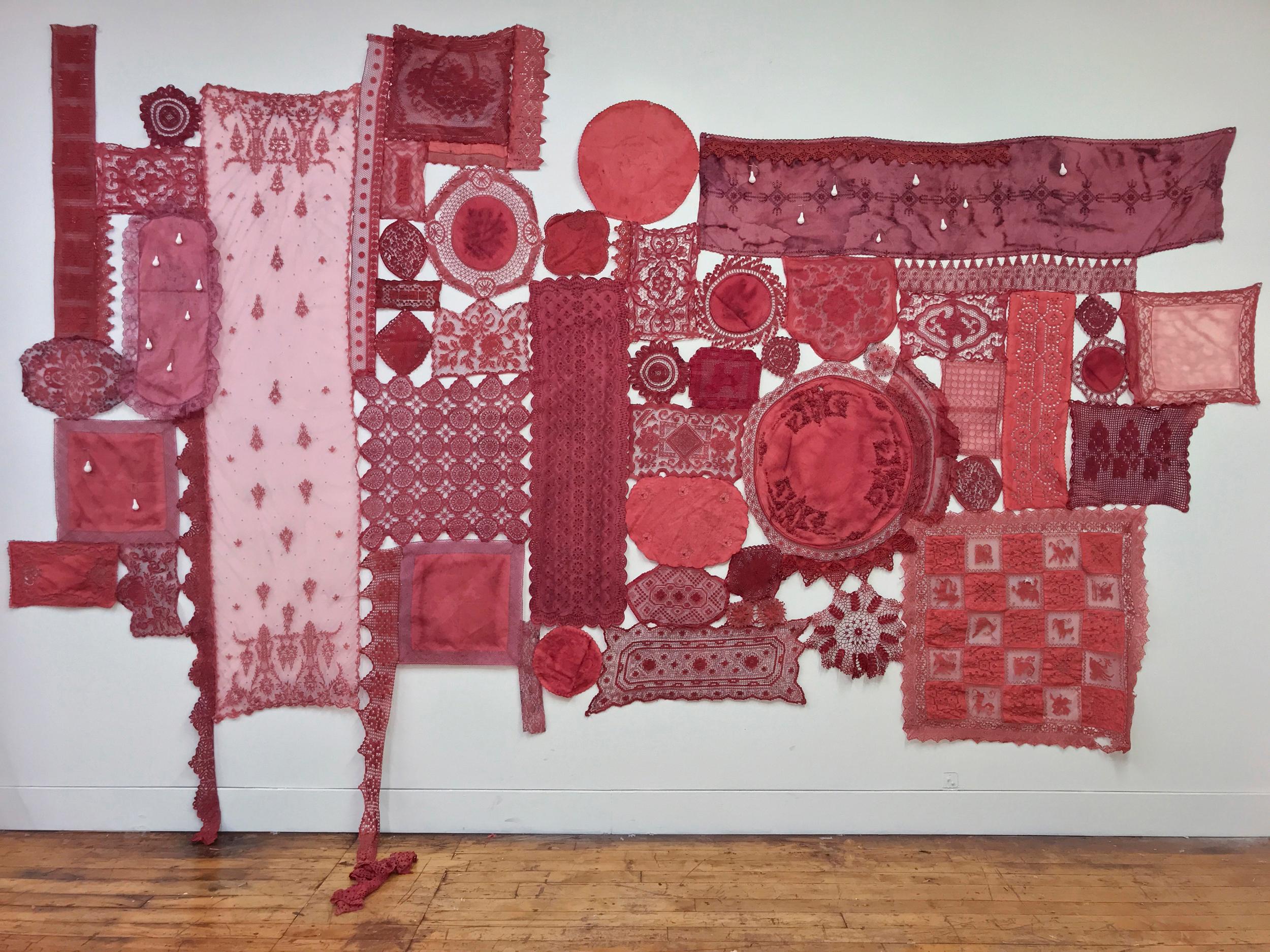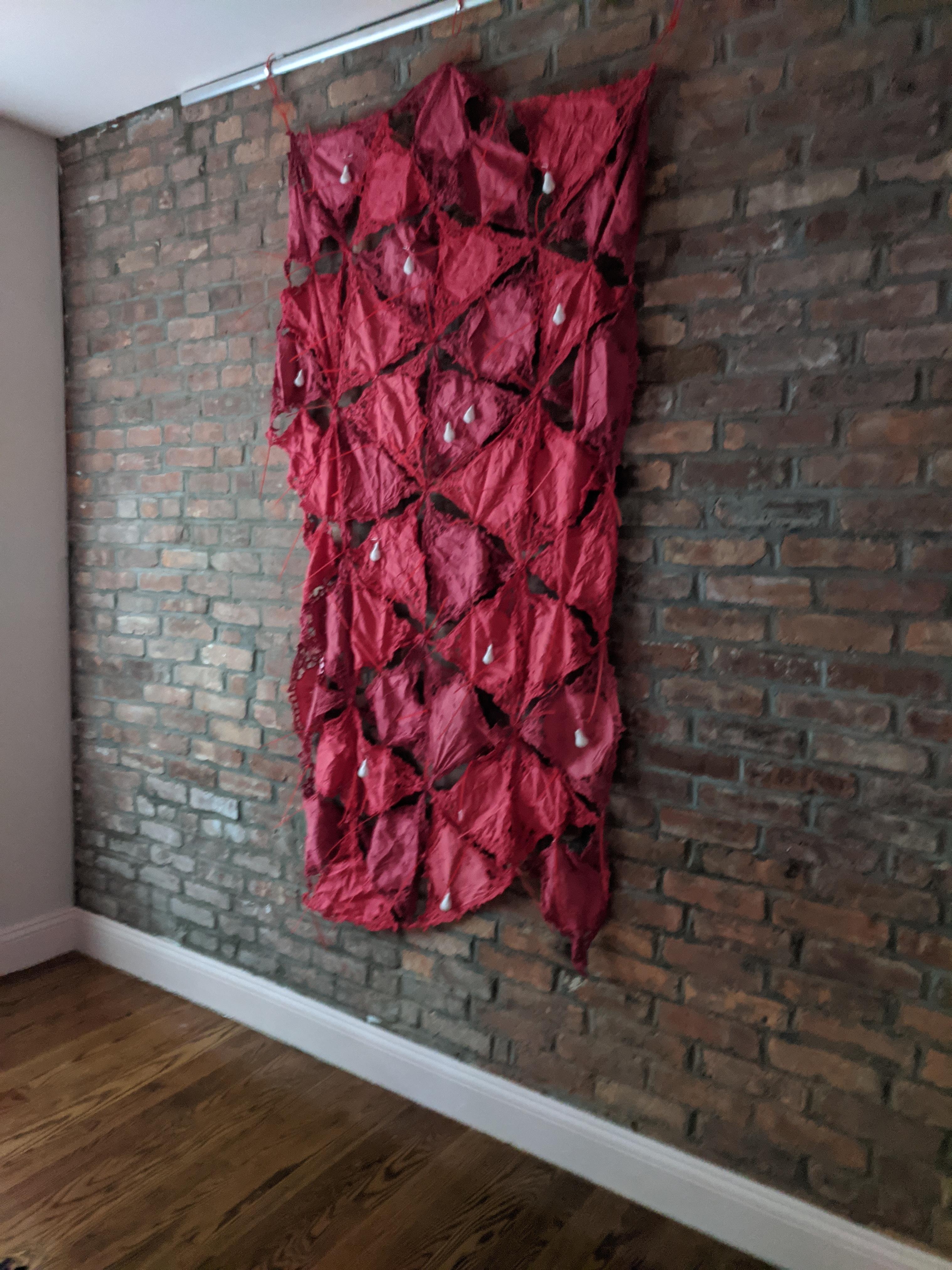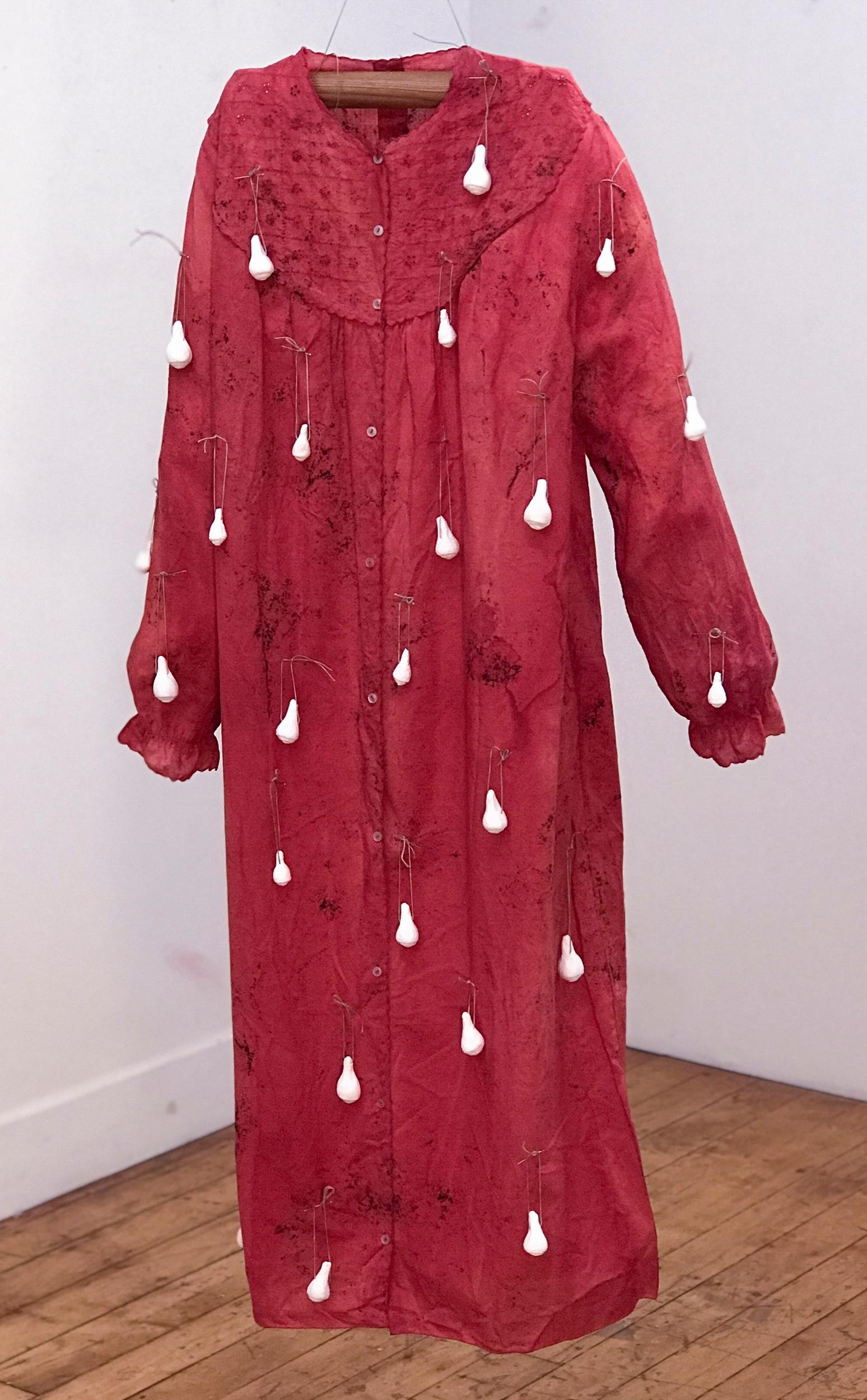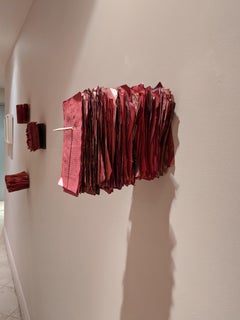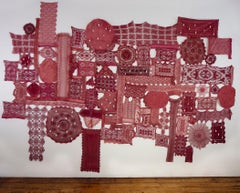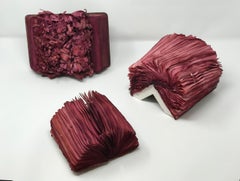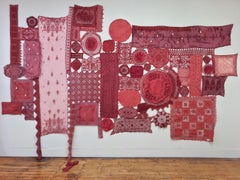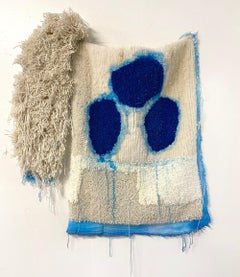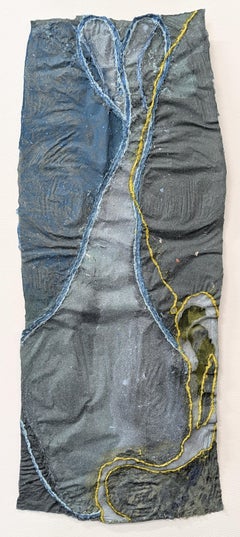Items Similar to Patricia Miranda, Pearls Before Swine 2020, cochineal dyes, pages, sewn pearls
Want more images or videos?
Request additional images or videos from the seller
1 of 3
Patricia MirandaPatricia Miranda, Pearls Before Swine 2020, cochineal dyes, pages, sewn pearls2016
2016
$1,250
£940.26
€1,083.81
CA$1,760.76
A$1,931.98
CHF 1,011.11
MX$23,776.09
NOK 12,738.43
SEK 11,931.44
DKK 8,092.69
About the Item
Patricia Miranda's work includes interdisciplinary installation, textile, paper and books. The textiles incorporated in these new pieces are vintage linens from her Italian and Irish grandmothers and sourced from friends and strangers around the country. Each donation is documented and integrated into the work. Textile as a form that wraps the body from cradle to grave. The role of lacemaking in the lives of women both economically and historically is packed with metaphorical potential. The relationship of craft and women’s work (re)appropriated by artists today to environmental and social issues is integral to the artist's research.
Her work is process oriented; materials are submerged in natural dyes from oak gall wasp nests, cochineal insects, turmeric, indigo, and clay. She forages for raw materials, cook dyes, grind pigments, ecofeminist actions that consider environmental impacts of objects. The process is left visible as dyestuff is unfiltered in the vat and finished work. Sewn into larger works, Miranda incorporates hair, pearls, bone beads, Milagros, cast plaster. The distinct genetics and environmental and cultural history of each material asserts its voice as collaborator rather than medium.
The lace inserts a visceral femininity into the pristine gallery, and exerts a ghostly trace of the history of domestic labor. The combination of earth and lace references human and environmental devastation and the conflation of nature and women’s bodies as justifications for exploitation. Mournful and solastalgic, they are lamentations to the violence against women and the earth.
Patricia Miranda is an interdisciplinary artist, curator, educator, and founder of The Crit Lab, graduate-level critique seminars and Residency for artists, and MAPSpace project space. She has been Visiting Artist at Vermont Studio Center, the Heckscher Museum, and University of Utah; and been awarded residencies at I-Park, Weir Farm, Vermont Studio Center, and Julio Valdez Printmaking Studio.
She received an Anonymous Was a Woman Covid19 Artist Relief Grant, an artist grant from ArtsWestchester/New York State Council on the Arts, and was part of a year-long NEA grant working with homeless youth.
Miranda currently teaches graduate curatorial studies at Western Colorado University, and develops programs for K-12, museums, and institutions such as Franklin Furnace.
Her work has been exhibited at ODETTA, NYC; ABC No Rio, NYC; Alexey von Schlippe Gallery at UConn, Groton, CT; Wave Hill, Bronx, NY; the Cape Museum of Fine Art, MA; the Belvedere Museum, Vienna, Austria.
- Creator:
- Creation Year:2016
- Dimensions:Height: 12 in (30.48 cm)Width: 10 in (25.4 cm)Depth: 2 in (5.08 cm)
- Medium:
- Movement & Style:
- Period:
- Condition:These book pages are framed and are in a series of seven works of art, priced at $1125 per artwork.
- Gallery Location:Darien, CT
- Reference Number:1stDibs: LU17226667372
About the Seller
5.0
Vetted Professional Seller
Every seller passes strict standards for authenticity and reliability
Established in 2014
1stDibs seller since 2015
145 sales on 1stDibs
- ShippingRetrieving quote...Shipping from: Darien, CT
- Return Policy
Authenticity Guarantee
In the unlikely event there’s an issue with an item’s authenticity, contact us within 1 year for a full refund. DetailsMoney-Back Guarantee
If your item is not as described, is damaged in transit, or does not arrive, contact us within 7 days for a full refund. Details24-Hour Cancellation
You have a 24-hour grace period in which to reconsider your purchase, with no questions asked.Vetted Professional Sellers
Our world-class sellers must adhere to strict standards for service and quality, maintaining the integrity of our listings.Price-Match Guarantee
If you find that a seller listed the same item for a lower price elsewhere, we’ll match it.Trusted Global Delivery
Our best-in-class carrier network provides specialized shipping options worldwide, including custom delivery.More From This Seller
View AllPatricia Miranda, Florilegium Series, 2016, cochineal dyes, antique books, pearl
By Patricia Miranda
Located in Darien, CT
Patricia Miranda's work includes interdisciplinary installation, textile, paper and books. The textiles incorporated in these new pieces are vintage linens from her Italian and Irish grandmothers and sourced from friends and strangers around the country. Each donation is documented and integrated into the work. Textile as a form that wraps the body from cradle to grave. The role of lacemaking in the lives of women both economically and historically is packed with metaphorical potential. The relationship of craft and women’s work (re)appropriated by artists today to environmental and social issues is integral to the artist's research.
Her work is process oriented; materials are submerged in natural dyes from oak gall wasp nests, cochineal insects, turmeric, indigo, and clay. She forages for raw materials, cook dyes, grind pigments, ecofeminist actions that consider environmental impacts of objects. The process is left visible as dyestuff is unfiltered in the vat and finished work. Sewn into larger works, Miranda incorporates hair, pearls, bone beads, Milagros, cast plaster. The distinct genetics and environmental and cultural history of each material asserts its voice as collaborator rather than medium.
The lace inserts a visceral femininity into the pristine gallery, and exerts a ghostly trace of the history of domestic labor. The combination of earth and lace references human and environmental devastation and the conflation of nature and women’s bodies as justifications for exploitation. Mournful and solastalgic, they are lamentations to the violence against women and the earth.
Patricia Miranda is an interdisciplinary artist, curator, educator, and founder of The Crit Lab, graduate-level critique seminars and Residency for artists, and MAPSpace project space. She has been Visiting Artist at Vermont Studio Center, the Heckscher Museum, and University of Utah; and been awarded residencies at I-Park, Weir Farm, Vermont Studio Center, and Julio Valdez Printmaking Studio.
She received an Anonymous Was a Woman Covid19 Artist Relief Grant, an artist grant from ArtsWestchester/New York State Council on the Arts, and was part of a year-long NEA grant working with homeless youth.
Miranda currently teaches graduate curatorial studies at Western Colorado University, and develops programs for K-12, museums, and institutions such as Franklin Furnace.
Her work has been exhibited at ODETTA, NYC; ABC No Rio, NYC; Alexey von...
Category
2010s Feminist Abstract Sculptures
Materials
Fabric, Thread, Plaster, Dye, Found Objects
Patricia Miranda, Lamentations for Ermenegilda; 2020, lace, cochineal dye, thread
By Patricia Miranda
Located in Darien, CT
Patricia Miranda's work includes interdisciplinary installation, textile, paper and books. The textiles incorporated in these new pieces are vintage linens from her Italian and Irish grandmothers and sourced from friends and strangers around the country. Each donation is documented and integrated into the work. Textile as a form that wraps the body from cradle to grave. The role of lacemaking in the lives of women both economically and historically is packed with metaphorical potential. The relationship of craft and women’s work (re)appropriated by artists today to environmental and social issues is integral to the artist's research.
Her work is process oriented; materials are submerged in natural dyes from oak gall wasp nests, cochineal insects, turmeric, indigo, and clay. She forages for raw materials, cook dyes, grind pigments, ecofeminist actions that consider environmental impacts of objects. The process is left visible as dyestuff is unfiltered in the vat and finished work. Sewn into larger works, Miranda incorporates hair, pearls, bone beads, Milagros, cast plaster. The distinct genetics and environmental and cultural history of each material asserts its voice as collaborator rather than medium.
The lace inserts a visceral femininity into the pristine gallery, and exerts a ghostly trace of the history of domestic labor. The combination of earth and lace references human and environmental devastation and the conflation of nature and women’s bodies as justifications for exploitation. Mournful and solastalgic, they are lamentations to the violence against women and the earth.
Patricia Miranda is an interdisciplinary artist, curator, educator, and founder of The Crit Lab, graduate-level critique seminars and Residency for artists, and MAPSpace project space. She has been Visiting Artist at Vermont Studio Center, the Heckscher Museum, and University of Utah; and been awarded residencies at I-Park, Weir Farm, Vermont Studio Center, and Julio Valdez Printmaking Studio.
She received an Anonymous Was a Woman Covid19 Artist Relief Grant, an artist grant from ArtsWestchester/New York State Council on the Arts, and was part of a year-long NEA grant working with homeless youth.
Miranda currently teaches graduate curatorial studies at Western Colorado University, and develops programs for K-12, museums, and institutions such as Franklin Furnace.
Her work has been exhibited at ODETTA, NYC; ABC No Rio, NYC; Alexey von...
Category
2010s Feminist Abstract Sculptures
Materials
Ceramic, Fabric, Thread, Dye, Found Objects
Patricia Miranda, Florilegium Series, 2016, cochineal dyes, antique books, pearl
By Patricia Miranda
Located in Darien, CT
Patricia Miranda's work includes interdisciplinary installation, textile, paper and books. The textiles incorporated in these new pieces are vintage linens from her Italian and Irish grandmothers and sourced from friends and strangers around the country. Each donation is documented and integrated into the work. Textile as a form that wraps the body from cradle to grave. The role of lacemaking in the lives of women both economically and historically is packed with metaphorical potential. The relationship of craft and women’s work (re)appropriated by artists today to environmental and social issues is integral to the artist's research.
Her work is process oriented; materials are submerged in natural dyes from oak gall wasp nests, cochineal insects, turmeric, indigo, and clay. She forages for raw materials, cook dyes, grind pigments, ecofeminist actions that consider environmental impacts of objects. The process is left visible as dyestuff is unfiltered in the vat and finished work. Sewn into larger works, Miranda incorporates hair, pearls, bone beads, Milagros, cast plaster. The distinct genetics and environmental and cultural history of each material asserts its voice as collaborator rather than medium.
The lace inserts a visceral femininity into the pristine gallery, and exerts a ghostly trace of the history of domestic labor. The combination of earth and lace references human and environmental devastation and the conflation of nature and women’s bodies as justifications for exploitation. Mournful and solastalgic, they are lamentations to the violence against women and the earth.
Patricia Miranda is an interdisciplinary artist, curator, educator, and founder of The Crit Lab, graduate-level critique seminars and Residency for artists, and MAPSpace project space. She has been Visiting Artist at Vermont Studio Center, the Heckscher Museum, and University of Utah; and been awarded residencies at I-Park, Weir Farm, Vermont Studio Center, and Julio Valdez Printmaking Studio.
She received an Anonymous Was a Woman Covid19 Artist Relief Grant, an artist grant from ArtsWestchester/New York State Council on the Arts, and was part of a year-long NEA grant working with homeless youth.
Miranda currently teaches graduate curatorial studies at Western Colorado University, and develops programs for K-12, museums, and institutions such as Franklin Furnace.
Her work has been exhibited at ODETTA, NYC; ABC No Rio, NYC; Alexey von...
Category
2010s Feminist Abstract Sculptures
Materials
Fabric, Thread, Plaster, Dye, Found Objects
Patricia Miranda, Lamentations for Rebecca; 2020, lace, cochineal dye, thread
By Patricia Miranda
Located in Darien, CT
Patricia Miranda's work includes interdisciplinary installation, textile, paper and books. The textiles incorporated in these new pieces are vintage linens from her Italian and Irish grandmothers and sourced from friends and strangers around the country. Each donation is documented and integrated into the work. Textile as a form that wraps the body from cradle to grave. The role of lacemaking in the lives of women both economically and historically is packed with metaphorical potential. The relationship of craft and women’s work (re)appropriated by artists today to environmental and social issues is integral to the artist's research.
Her work is process oriented; materials are submerged in natural dyes from oak gall wasp nests, cochineal insects, turmeric, indigo, and clay. She forages for raw materials, cook dyes, grind pigments, ecofeminist actions that consider environmental impacts of objects. The process is left visible as dyestuff is unfiltered in the vat and finished work. Sewn into larger works, Miranda incorporates hair, pearls, bone beads, Milagros, cast plaster. The distinct genetics and environmental and cultural history of each material asserts its voice as collaborator rather than medium.
The lace inserts a visceral femininity into the pristine gallery, and exerts a ghostly trace of the history of domestic labor. The combination of earth and lace references human and environmental devastation and the conflation of nature and women’s bodies as justifications for exploitation. Mournful and solastalgic, they are lamentations to the violence against women and the earth.
Patricia Miranda is an interdisciplinary artist, curator, educator, and founder of The Crit Lab, graduate-level critique seminars and Residency for artists, and MAPSpace project space. She has been Visiting Artist at Vermont Studio Center, the Heckscher Museum, and University of Utah; and been awarded residencies at I-Park, Weir Farm, Vermont Studio Center, and Julio Valdez Printmaking Studio.
She received an Anonymous Was a Woman Covid19 Artist Relief Grant, an artist grant from ArtsWestchester/New York State Council on the Arts, and was part of a year-long NEA grant working with homeless youth.
Miranda currently teaches graduate curatorial studies at Western Colorado University, and develops programs for K-12, museums, and institutions such as Franklin Furnace.
Her work has been exhibited at ODETTA, NYC; ABC No Rio, NYC; Alexey von...
Category
2010s Feminist Abstract Sculptures
Materials
Ceramic, Fabric, Thread, Dye, Found Objects
Patricia Miranda, Sentinella, 2020, Battinger lace, synthetic dyes, cast plaster
By Patricia Miranda
Located in Darien, CT
Patricia Miranda's work includes interdisciplinary installation, textile, paper and books. The textiles incorporated in these new pieces are vintage linens from her Italian and Irish grandmothers and sourced from friends and strangers around the country. Each donation is documented and integrated into the work. Textile as a form that wraps the body from cradle to grave. The role of lacemaking in the lives of women both economically and historically is packed with metaphorical potential. The relationship of craft and women’s work (re)appropriated by artists today to environmental and social issues is integral to the artist's research.
Her work is process oriented; materials are submerged in natural dyes from oak gall wasp nests, cochineal insects, turmeric, indigo, and clay. She forages for raw materials, cook dyes, grind pigments, ecofeminist actions that consider environmental impacts of objects. The process is left visible as dyestuff is unfiltered in the vat and finished work. Sewn into larger works, Miranda incorporates hair, pearls, bone beads, Milagros, cast plaster. The distinct genetics and environmental and cultural history of each material asserts its voice as collaborator rather than medium.
The lace inserts a visceral femininity into the pristine gallery, and exerts a ghostly trace of the history of domestic labor. The combination of earth and lace references human and environmental devastation and the conflation of nature and women’s bodies as justifications for exploitation. Mournful and solastalgic, they are lamentations to the violence against women and the earth.
Patricia Miranda is an interdisciplinary artist, curator, educator, and founder of The Crit Lab, graduate-level critique seminars and Residency for artists, and MAPSpace project space. She has been Visiting Artist at Vermont Studio Center, the Heckscher Museum, and University of Utah; and been awarded residencies at I-Park, Weir Farm, Vermont Studio Center, and Julio Valdez Printmaking Studio.
She received an Anonymous Was a Woman Covid19 Artist Relief Grant, an artist grant from ArtsWestchester/New York State Council on the Arts, and was part of a year-long NEA grant working with homeless youth.
Miranda currently teaches graduate curatorial studies at Western Colorado University, and develops programs for K-12, museums, and institutions such as Franklin Furnace.
Her work has been exhibited at ODETTA, NYC; ABC No Rio, NYC; Alexey von...
Category
2010s Feminist Abstract Sculptures
Materials
Fabric, Dye, Plastic
Patricia Miranda, Dreaming Awake, 2020, nightdress, cochineal dyes, plaster,
By Patricia Miranda
Located in Darien, CT
Patricia Miranda's work includes interdisciplinary installation, textile, paper and books. The textiles incorporated in these new pieces are vintage linens from her Italian and Irish grandmothers and sourced from friends and strangers around the country. Each donation is documented and integrated into the work. Textile as a form that wraps the body from cradle to grave. The role of lacemaking in the lives of women both economically and historically is packed with metaphorical potential. The relationship of craft and women’s work (re)appropriated by artists today to environmental and social issues is integral to the artist's research.
Her work is process oriented; materials are submerged in natural dyes from oak gall wasp nests, cochineal insects, turmeric, indigo, and clay. She forages for raw materials, cook dyes, grind pigments, ecofeminist actions that consider environmental impacts of objects. The process is left visible as dyestuff is unfiltered in the vat and finished work. Sewn into larger works, Miranda incorporates hair, pearls, bone beads, Milagros, cast plaster. The distinct genetics and environmental and cultural history of each material asserts its voice as collaborator rather than medium.
The lace inserts a visceral femininity into the pristine gallery, and exerts a ghostly trace of the history of domestic labor. The combination of earth and lace references human and environmental devastation and the conflation of nature and women’s bodies as justifications for exploitation. Mournful and solastalgic, they are lamentations to the violence against women and the earth.
Patricia Miranda is an interdisciplinary artist, curator, educator, and founder of The Crit Lab, graduate-level critique seminars and Residency for artists, and MAPSpace project space. She has been Visiting Artist at Vermont Studio Center, the Heckscher Museum, and University of Utah; and been awarded residencies at I-Park, Weir Farm, Vermont Studio Center, and Julio Valdez Printmaking Studio.
She received an Anonymous Was a Woman Covid19 Artist Relief Grant, an artist grant from ArtsWestchester/New York State Council on the Arts, and was part of a year-long NEA grant working with homeless youth.
Miranda currently teaches graduate curatorial studies at Western Colorado University, and develops programs for K-12, museums, and institutions such as Franklin Furnace.
Her work has been exhibited at ODETTA, NYC; ABC No Rio, NYC; Alexey von...
Category
2010s Feminist Abstract Sculptures
Materials
Fabric, Thread, Dye, Found Objects, Plaster
You May Also Like
Nancy Cohen "Rose Lines" 2024 paper pulp, kozo fiber and handmade paper
By Nancy Cohen
Located in New York, NY
Nancy Cohen
Rose Lines, 2024
paper pulp, kozo fiber and handmade paper
17 x 49 in
(coh109)
Category
2010s Contemporary Mixed Media
Materials
Paper, Handmade Paper
Textile Wall Sculture: 'THE FUGITIVE'
By Judy Rushin-Knopf
Located in New York, NY
This piece is from a new body of work called 'Vital Signs’ which will premiere at Ivy Brown Gallery in NYC and springs from the domain of hospitals and illness through combinations of hand-woven and tufted textiles and minimalist box-like objects that hang on walls or embed in the textiles themselves. The textiles refer to items of worn clothing, flattened identity, and superstition that come with illness and extended hospital stays. Their dominant color is blue, a hue known to calm the nervous system, but also the color of a failing body (cyanosis). The black and white objects...
Category
2010s Contemporary Abstract Sculptures
Materials
Mixed Media
"Weighted" 2025 paper pulp and handmade paper
By Nancy Cohen
Located in New York, NY
Nancy Cohen
Weighted, 2025
paper pulp and handmade paper
24 x 10 in.
(coh114)
Category
2010s Abstract Mixed Media
Materials
Handmade Paper
Ceramic and textile sculpture: 'No. 6'
By Ak Jansen
Located in New York, NY
This is part of a collection of ceramics, textiles, and drawings by Ak Jansen which comprise his first solo show in New York City. Born in the Netherlands, Jansen’s work occupies que...
Category
2010s Contemporary Abstract Sculptures
Materials
Gold
Paper Artwork with Stone, Abstract Red with Movement, 3-d, Climate Change, 2020
Located in San Francisco, CA
"Land Erosion" by Bianca Severijns is a masterpiece of movement and texture. She paints, hand tears, and glues pieces of paper, creating waves of abstraction. With the theme of clima...
Category
2010s Abstract More Art
Materials
Stone
Textile Wall Sculpture: 'SSSSLACKZZZZ'
By Judy Rushin-Knopf
Located in New York, NY
This piece is from a new body of work called 'Vital Signs’ which will premiere at Ivy Brown Gallery in NYC springs from the domain of hospitals and illness through combinations of hand-woven and tufted textiles and minimalist box-like objects that hang on walls or embed in the textiles themselves. The textiles refer to items of worn clothing, flattened identity, and superstition that come with illness and extended hospital stays. Their dominant color is blue, a hue known to calm the nervous system, but also the color of a failing body (cyanosis). The black and white objects...
Category
2010s Contemporary Abstract Sculptures
Materials
Mixed Media
More Ways To Browse
Large Plaster Relief
Bone Beads
Italian Plaster Relief
Pearls Before Swine
Koi Mirror
Leon Gischia
Louis Vuitton Nike
Marian B
Marlboro Light
Mexican Folk Art Angels
Mick Jagger Poster Vintage
Mr Doodle
Paris Scene Painting Signed Andrea
Pepsi Bottle
Pepsi Bottles
Persian Art Antique Framed
Pointer Dog Painting
Rat Terrier
